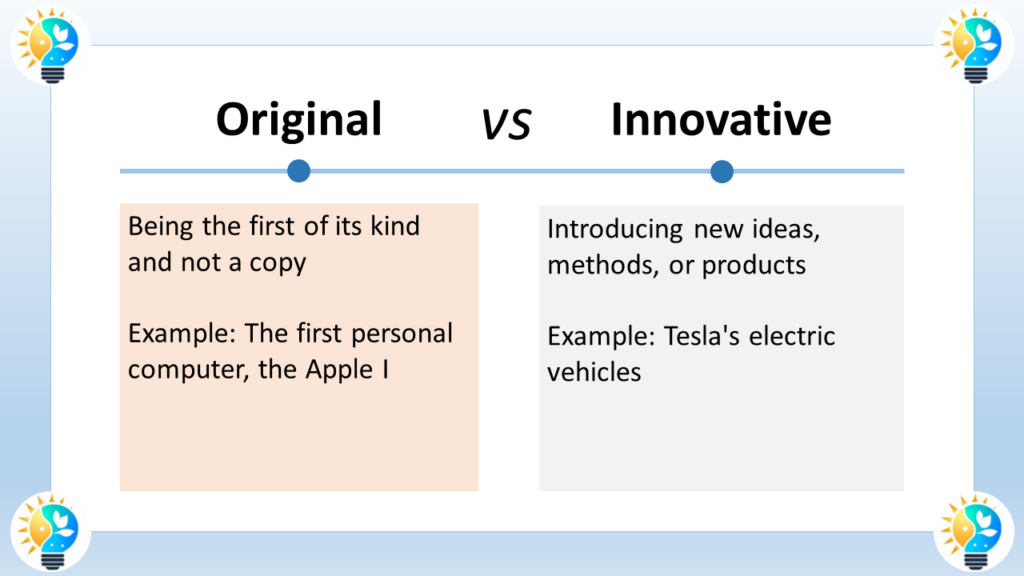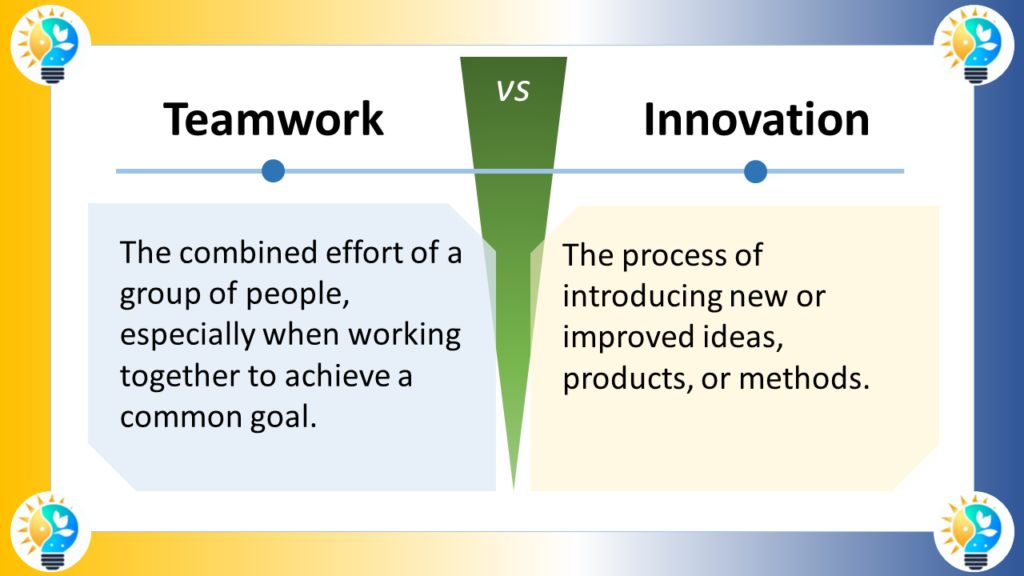Both terms involve originality, but “innovative” implies a practical application or implementation of new ideas, while “original” refers to the authorship or creation of something new.

Innovative vs. Original: Understanding the Differences
When it comes to creativity and newness, two terms often come to mind: innovative and original. While these words may seem synonymous, they convey different aspects of how something new is brought into being or perceived.
Definitions
Innovative
Definition: Innovation involves introducing something new or doing something in a new way that adds value or solves a problem. It often implies an improvement upon existing ideas, methods, or products.
Focus: The focus of innovation is on the process of creating and applying new ideas in a way that leads to effective change or advancements. This can include developing new technologies, creating more efficient processes, or finding new solutions to persistent problems.
Example: An innovative approach to sustainable energy might involve developing a new type of solar panel that is significantly more efficient than existing models, thus reducing our reliance on fossil fuels.
Original
Definition: Something original is the first of its kind and not derived from something else. It is new and unique in its origin or creation.
Focus: Originality emphasizes uniqueness and the fact that the concept, idea, or product has not been seen before and does not borrow from previous works or ideas.
Example: An original work of art means that the piece was created from the artist’s own ideas without copying any existing artworks.
Innovative Terms

Innovation is considered as a driving force in progress.
It includes the introduction of novel ideas, methods, or products that bring positive change and advancement.
For more information about innovations, check our glossary
Key Differences
In summary, while both innovative and original relate to newness, innovation is about applying new ideas to improve or advance something, often with a focus on utility and effectiveness. Originality, on the other hand, is about being the first, emphasizing uniqueness and the absence of derivation from previous works or ideas.
An original idea might not necessarily be innovative if it doesn’t lead to improvement. For example, a completely new and unique type of toy might be original but not necessarily innovative if it doesn’t offer any new benefits or solve any problems.
Similarly, an innovative idea may not be completely original if it builds upon or improves existing concepts. For instance, a new smartphone app that streamlines the process of booking medical appointments might be innovative, but it’s not entirely original if similar apps already exist.
Understanding the difference between innovative and original can help individuals and organizations better appreciate the value of both concepts and work towards fostering an environment that encourages both originality and innovation.
FAQ: Innovative vs. Original – Understanding the Differences
- What is the difference between innovative and original?
Innovative refers to introducing something new or doing something in a new way that adds value or solves a problem, often building upon existing ideas. In contrast, original refers to being the first of its kind and not derived from something else, emphasizing uniqueness and independence from previous works or ideas.
- Does something innovative have to be original?
Not necessarily. An innovative idea may not be completely original if it builds upon or improves existing concepts. However, an innovative idea is still valuable as it introduces new benefits or solves problems more effectively than previous solutions.
- Can something be original but not innovative?
Yes, something can be original but not necessarily innovative. For example, a completely new and unique type of toy might be original but not innovative if it doesn’t offer any new benefits or solve any problems.
- Why is it important to distinguish between innovative and original?
Understanding the difference between innovative and original can help individuals and organizations better appreciate the value of both concepts, fostering an environment that encourages both originality and innovation.
- How can I foster an environment that encourages both originality and innovation?
Create a culture that values creativity, encourages experimentation, and rewards new ideas and improvements. Provide opportunities for employees to collaborate, share knowledge, and access resources that can help them develop and implement their original and innovative ideas.
- What role do leaders play in fostering innovation and originality?
Leaders play a crucial role in creating a culture that encourages innovation and originality. They can set goals and expectations, allocate resources, and provide feedback and recognition to help teams achieve their most innovative and original ideas.
- How can I ensure that my innovative ideas are also original?
Before developing and implementing an innovative idea, research the market and existing solutions to ensure that your idea is indeed original and not just a rehash of something already available. Consider seeking feedback from experts and potential users to validate your concept’s originality and potential value.
- How can I measure the success of my innovative or original ideas?
Measure the success of your innovative or original ideas by setting clear objectives and tracking relevant metrics, such as user engagement, revenue growth, or cost savings. Continuously gather feedback from stakeholders and adapt your approach as needed to ensure your ideas deliver the desired results.
- What are some examples of original and innovative ideas?
Examples of original and innovative ideas include the invention of the World Wide Web, the development of the first electric car, and the creation of Airbnb’s peer-to-peer home sharing platform.
- What are the benefits of promoting innovation and originality in the workplace?
Promoting innovation and originality in the workplace can lead to improved productivity, better employee engagement, increased competitiveness, and new revenue streams. It can also foster a culture of continuous learning and growth, attracting top talent and enhancing the organization’s reputation.


